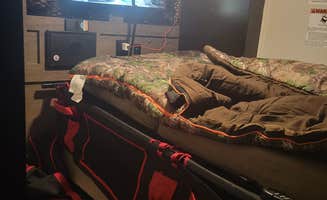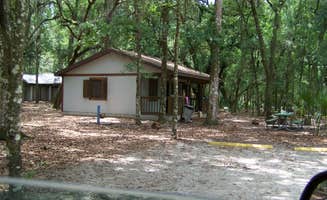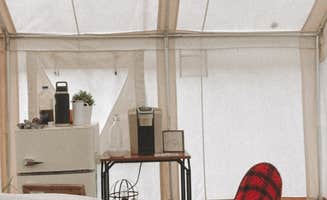Fort De Soto Campground and Terry Tomalin Campground are located in parks near Tampa Bay, with Seminole situated between these coastal destinations and the Gulf of Mexico. The region features a subtropical climate with hot, humid summers and mild winters, making year-round camping possible. These parks offer waterfront camping opportunities where wildlife viewing is common, including dolphins, manatees and numerous bird species within the mangrove ecosystems.
What to do
Biking on paved trails: Hillsborough River State Park offers excellent biking opportunities through natural Florida landscapes. "There are plenty of options for biking and hiking. Good Verizon signal to allow for plenty of streaming," notes Rick G.
Wildlife watching: Numerous waterways provide habitat for diverse wildlife. "Great park with days worth of activities! Tons of wildlife - we saw raccoons, dolphin, manatee, tons of birds!" shares Brennan H. about his camping experience.
Kayaking through mangroves: E.G. Simmons Regional Park offers direct water access for paddlers. "We were in site 55 of the East CG which was right on the water where we launched our kayaks to paddle the canals amongst the Mangroves," reports Bran P. The park also rents kayaks for those without their own equipment.
Fishing opportunities: Coastal parks provide excellent fishing spots in protected waters. "The area surrounding the campground has great fishing back in the canals and Cockroach Bay is up the road for good kayaking and fishing there," says B M. about E.G. Simmons Regional Park.
What campers like
Waterfront camping sites: At Fort De Soto Campground, campers appreciate the water views and access. "Many sites are waterfront and are mostly well separated. Great bike trails. Restrooms are dated but well maintained. Electric and water. 2 dump sites on property," explains David G.
Privacy between sites: Natural vegetation creates separation between campsites. "The sites have plenty of options for both clothes lines and hammocks. They did a great job at keeping a lot of natural growth to maintain privacy and a true tropical feel," notes Joe R. about Fort De Soto.
Clean facilities: Most parks maintain their amenities well. "The bath house is pretty central and literally across the road from our site. We had expected a much further walk based on the map, but it was just a 1 minute walk," reports a camper about the convenience of facilities.
Nature trails: Jay B. Starkey Wilderness Park offers extensive trail systems. "Starkey is an amazing spot. The site was spacious and many trees to hammock from, but the best part was the field directly in back of the site that is easily accessible," shares Shaun C.
What you should know
Reservation requirements: Most popular glamping sites need advance booking. "Book in advance, especially if you want to stay more than a night or two," advises Taylor T. about Fort De Soto.
Bug protection essential: Insects can be problematic, especially at dusk. "During the day, go out and fish, kayak, grill or hang at the beach. Lots of things to do here and great waterfront sites available on first come first serve basis," notes Christy C. about E.G. Simmons, while warning about "no-see-ums" in the evening.
Gate hours: Some parks have restricted access times. "The gates to the area did close a little earlier than I would like," mentions Nick P., which can affect late arrivals or evening activities outside the park.
Noise levels vary by day: Starkey Wilderness Preserve experiences different crowd levels throughout the week. "If you are hoping for peace and quiet, do not go on a weekend. I went on a Friday night, and the entire campground was packed. Very loud," cautions Shaun C.
Tips for camping with families
Playground access: Many parks offer child-friendly recreation areas. "There is a playground with good swings and also a sturdy playground that offered plenty of opportunity for my four year old to blow off some steam. The ground is all recycled rubber, which I love as a parent," explains Joe R.
Educational opportunities: Terry Tomalin Campground offers nature learning experiences. "This place was newly renovated for guests to stay. The campsites are nicely spaced out so you aren't too close to other campers. The trails are amazing but be careful or you might get lost," warns Caleb H.
Beach proximity: Several glamping locations provide easy access to swimming areas. "There is a beach area. Public swim area and picnic area. Lots of paved roads which was great for biking," shares Bran P. about the family-friendly amenities.
Wildlife encounters: Morning animal sightings create memorable experiences for children. "We were greeted by dolphins, sting rays and manatees," recalls a camper about their waterfront experience.
Tips from RVers
Site selection matters: For RVers visiting glamping areas near Seminole, Florida, choosing the right site makes a difference. "We needed a campsite near Tampa FL for a few days to meet friends visiting the area from up north. Being a Floridian, we've experienced FL's state parks and found them to offer privacy between sites," shares Rick G.
RV size considerations: Not all glamping locations accommodate larger rigs. "The sites all have full hook up, but we had a premium site and it was on a patch of dirt/grass. I would recommend any of the few concrete sites if you can get one," advises John G. about seasonal considerations.
Hookup variations: Different parks offer various utility connections. "Paved roads, packed sand and grass sites, 30A and water at each site, two separate campgrounds each with a dump station and bath house," notes Bran P., detailing the amenities available for RV campers.




